Key takeaways:
- Initial experience with street art started as a form of rebellion, evolving into a means to spark conversations and challenge perceptions.
- Finding inspiration from urban landscapes, meaningful conversations, and travel led to a rich exploration of themes and styles in artwork.
- Developing a unique style involved experimentation, self-reflection, and community engagement, resulting in art that resonates deeply with shared human experiences.
- Evolving as an artist emphasized collaboration and vulnerability, reinforcing the idea that art connects people and communicates personal narratives.
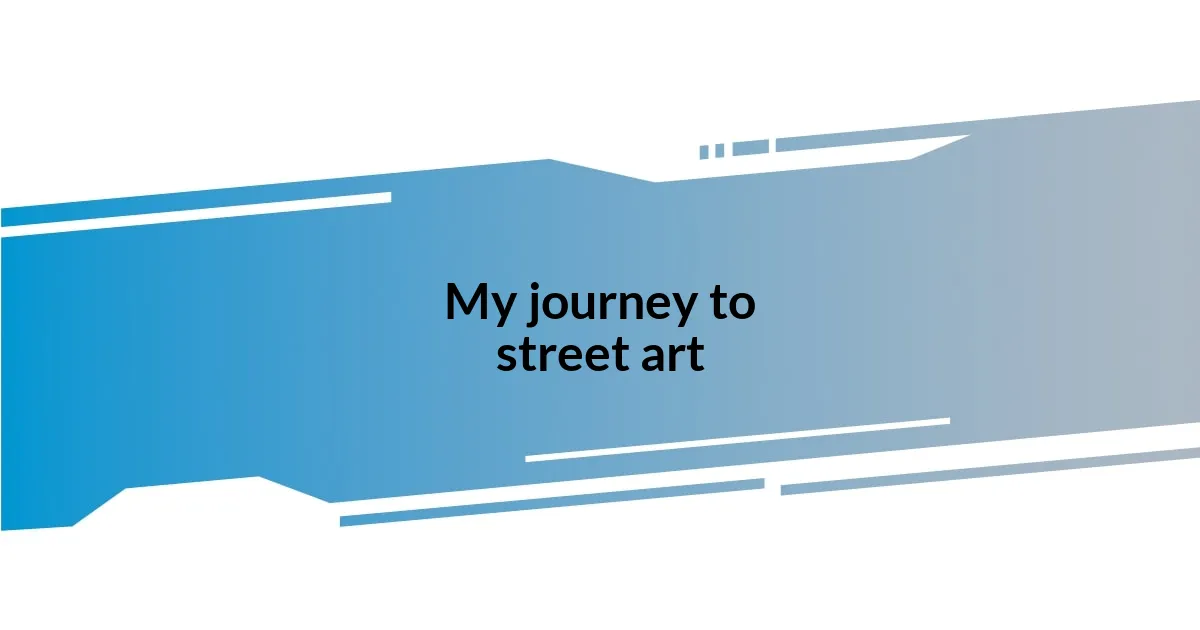
My journey to street art
I remember the first time I picked up a spray can. I was nervous, standing in front of a blank wall, my heart racing. Did I have what it took to create something meaningful? With each stroke, that doubt faded, and I felt a rush of freedom as colors splashed onto the surface.
Street art for me began as a silent rebellion. Growing up, I often felt stifled by rules and expectations. What if I could transform my surroundings into a canvas that reflected my truth? As I began experimenting with different styles, I discovered not just an art form, but a voice that resonated with my emotions and experiences.
One memorable project was a mural I painted in my neighborhood. Working alongside other artists, I felt a deep sense of community and connection. It was exhilarating to see our collective vision come to life, inviting passersby to stop, reflect, and feel. How could something so simple as a wall become a space for dialogue? That realization solidified my passion for street art—it was more than just painting; it was about sparking conversations and challenging perceptions.
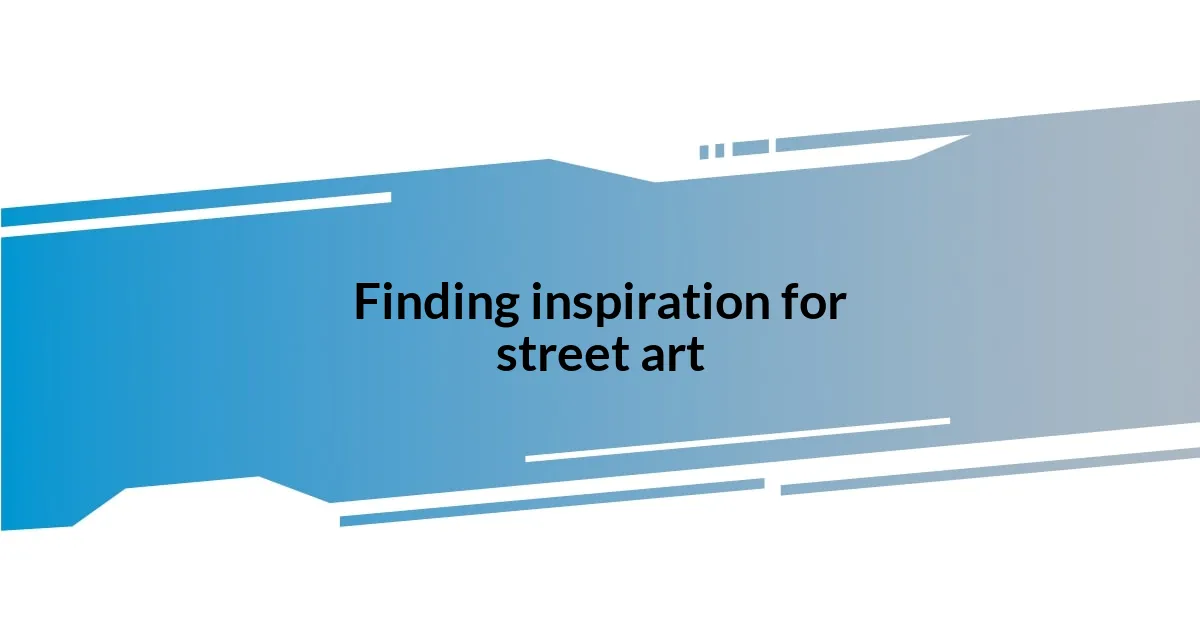
Finding inspiration for street art
Finding inspiration for street art can often feel like a personal journey. I’ve discovered that my surroundings profoundly influence my creativity. Wandering through urban landscapes, each corner tells a story—dilapidated buildings often express a kind of beauty that begs to be captured. The graffiti I encountered during a late-night walk sparked an idea in my mind. It was as if the walls whispered, inviting me to share my own narrative through vibrant colors and bold shapes.
I remember an afternoon spent in a local café, sketching images inspired by conversations around me. Each dialogue planted a seed of inspiration that later transformed into ideas for my artworks. It struck me how societal issues often resonated in my heart. When I witnessed the struggles of my community, it became clear that I needed to channel this emotion into my art. Have you ever felt compelled to express a feeling that words simply couldn’t capture? Street art granted me that liberation—it’s my way of vocalizing my thoughts and feelings in a world that sometimes feels muted.
Traveling has also played a critical role in my artistic journey. Each city showcases a unique blend of culture, styles, and sentiments. I learned that art transcends language, connecting us through shared experiences. One time, I collaborated with artists from an entirely different background during a festival. We exchanged ideas, melding our unique styles into one mural. That collaboration opened my eyes to endless possibilities of expression and reinforced the idea that inspiration is indeed everywhere if we are willing to look and listen.
| Source of Inspiration | Description |
|---|---|
| Urban Landscapes | Dilapidated buildings and hidden corners tell stories through their wear and tear. |
| Conversations | Sketching ideas inspired by dialogues can lead to deeply personal art pieces. |
| Travel | Exposure to different cultures creates opportunities for rich artistic collaborations. |
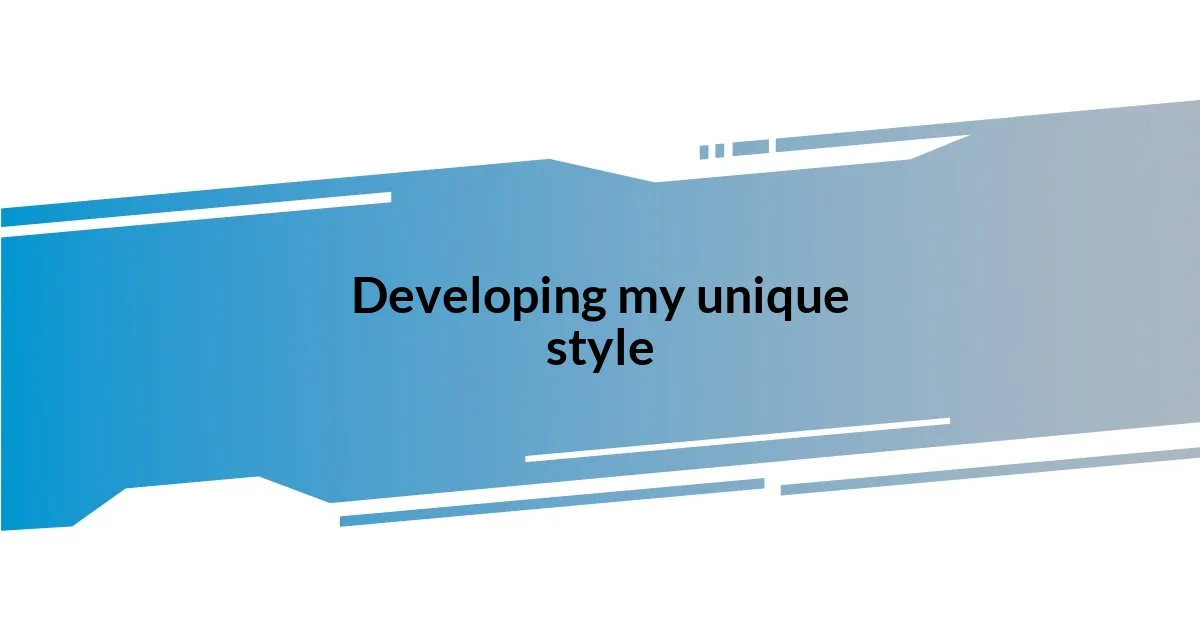
Developing my unique style
Developing my unique style felt like peeling back layers of my identity. Each time I picked up a can, I experimented with different techniques, trying to capture not just the aesthetic but also the essence of who I am. One day, I took an unexpected turn; instead of focusing solely on vibrant colors, I started incorporating mixed media elements. A collage of materials from my past—newspaper clippings, fabric scraps—added depth to my work. This shift revealed a deeper connection to my experiences, inviting my audience into my world.
- Experimentation: I began to layer materials and textures, revealing more about my journey.
- Self-reflection: Every artwork became a snapshot of my thoughts and emotions at that moment.
- Feedback: Sharing my work with others helped refine my style; their reactions were often eye-opening.
- Evolution: I embraced change in my art, allowing it to evolve as I did, reflecting my growth.
I recall a particularly poignant moment while painting a piece that depicted a significant loss in my life. It wasn’t just about the imagery; it was about the feeling behind it. As I applied each stroke, I felt the weight of my emotions pour onto the wall. The piece became a cathartic release, and strangely enough, it drew in others who shared similar experiences. With each interaction, I understood that my art was not just a reflection of myself—it resonated with the shared human experience.
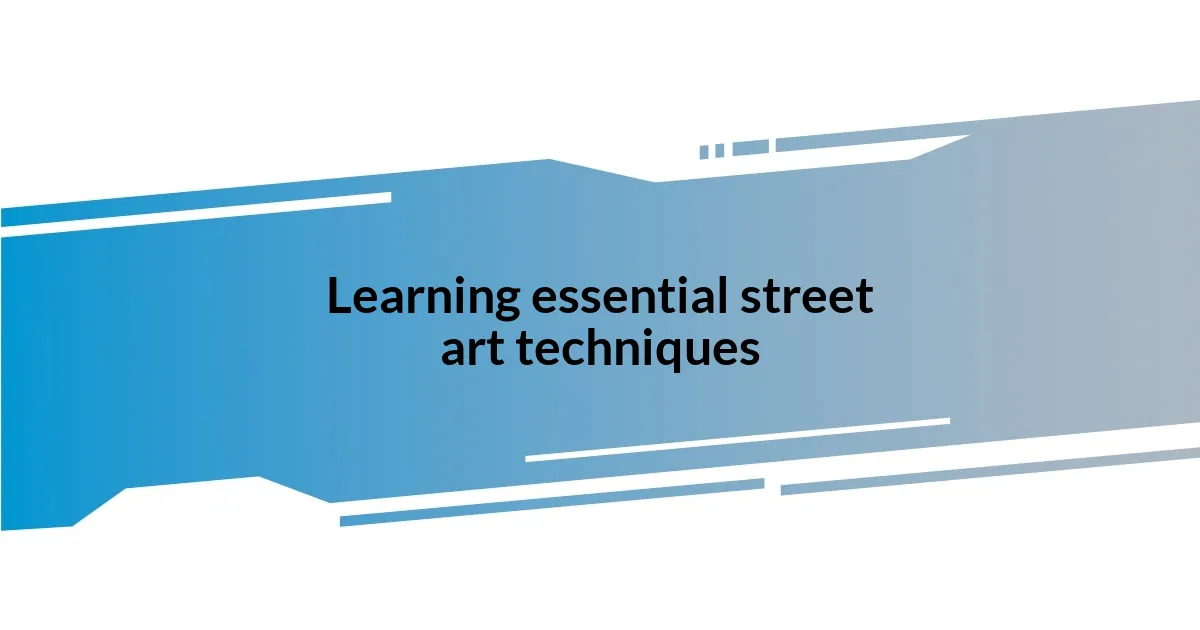
Learning essential street art techniques
Learning essential street art techniques became a transformative part of my artistic journey. I remember standing in front of a blank wall, feeling a mix of excitement and fear. What if my work didn’t turn out as I envisioned? It was during those moments that I realized the importance of practice—spending hours honing my spray can skills and understanding how to control the flow of paint. Each trial was a lesson, from mastering gradients to perfecting sharp lines. I learned that the act of creating is just as valuable as the final piece.
One technique that significantly influenced my style was stenciling. I ventured into it when I wanted to express a message concisely. The first time I used a stencil, I felt a rush of adrenaline as I pressed down the spray can and revealed the image. It wasn’t perfect, but that rawness added character. Have you ever felt the thrill of discovering a new technique? It opened a door for me, allowing my art to become a dialogue with the viewer, conveying complex emotions with simple visuals. I found that stencils could not only streamline my creative process but also make my messages clearer.
Layering different mediums was another game-changer. I experimented by combining acrylics, spray paint, and even digital art elements. One afternoon in my studio, I tried layering a digital print over my traditional spray work. The clash of textures made the piece come alive in a way I never expected. It became an exploration of how different forms can coexist and communicate. I wondered—how can we push the boundaries of our art? Discovering these techniques enriched my creativity and pushed me to continually innovate and share my evolving story with the streets.
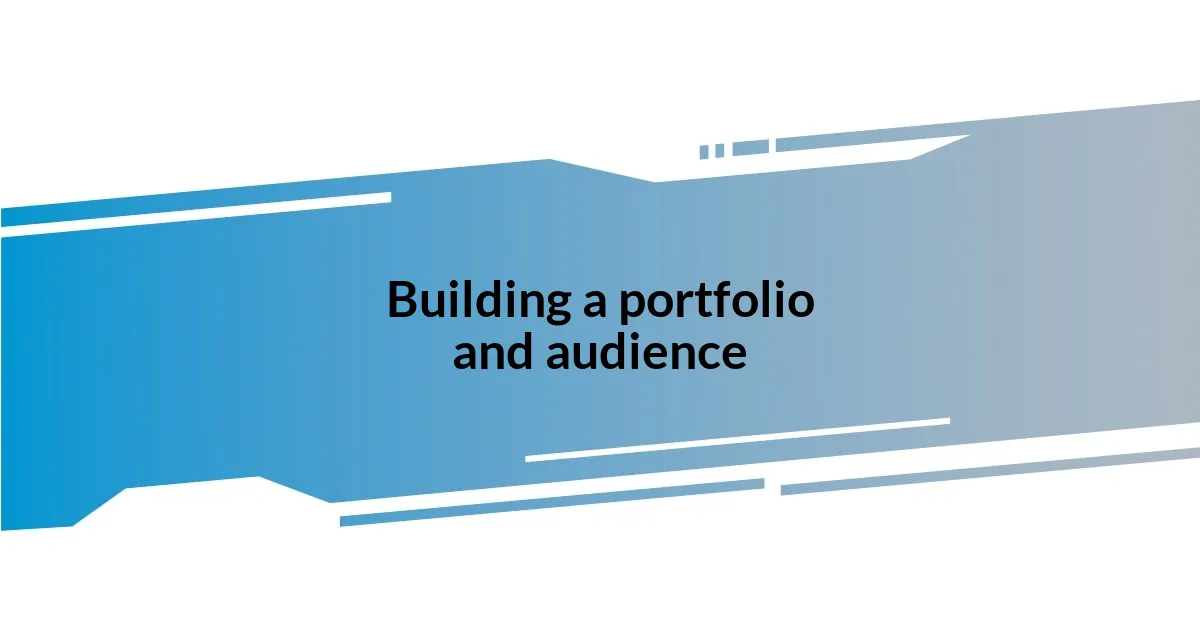
Building a portfolio and audience
Building a portfolio was more than just compiling my artwork; it felt like narrating my journey as a street artist. I started with a modest collection of pieces, each representing a moment in time. I vividly remember the thrill of sharing my work on social media for the first time. Did the world even want to see what I had created? To my surprise, the response was overwhelmingly positive, which encouraged me to keep going and refine my art.
As my portfolio grew, I ventured into local art shows and community events. I recall chatting with other artists and the electric feeling of camaraderie that fueled our creativity. It was a space where I not only showcased my work but also learned from others. What resonated with their audiences? What techniques did they use to draw people in? These interactions not only influenced my style but also expanded my understanding of audience connection—a vital element in street art.
I soon realized that building an audience wasn’t just about exposure; it required genuine engagement. I couldn’t simply drop a piece in a popular location and walk away. I started hosting impromptu live painting sessions, inviting passersby to join me. There’s nothing quite like the spark in someone’s eyes when they see art taking shape. It dawned on me—art isn’t just created; it’s shared and experienced together. I found that by fostering community and sharing stories behind my pieces, I could create a deeper connection with my audience, turning them into supporters who truly valued my work.
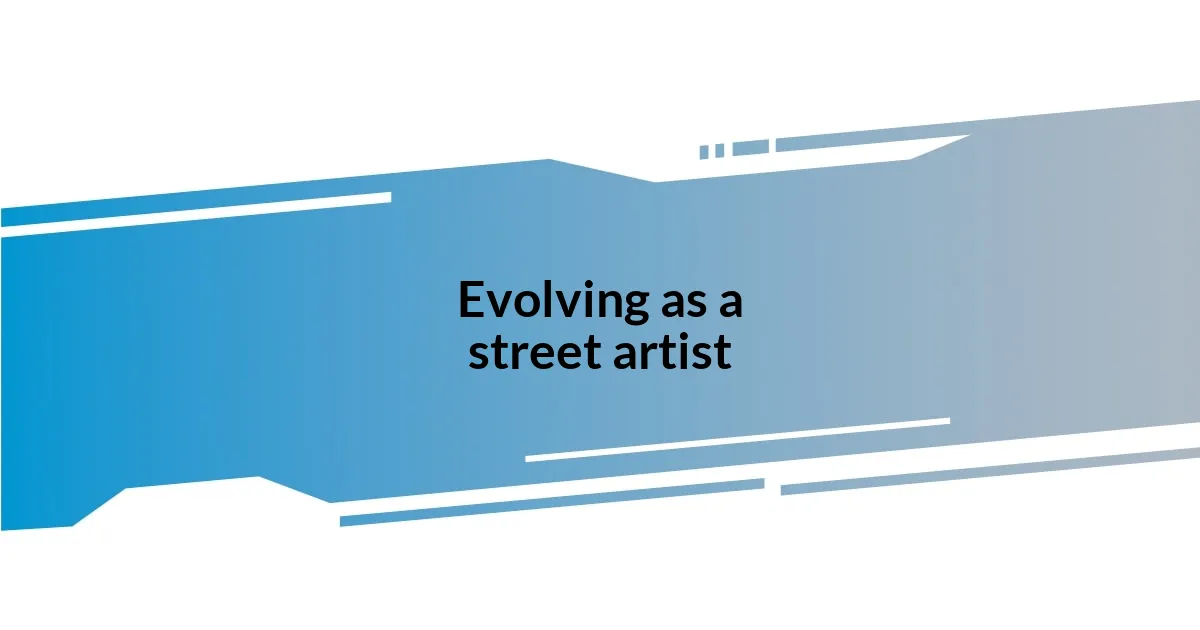
Evolving as a street artist
Evolving as a street artist meant diving deeper into the core of my emotions and experiences. One evening, I found myself in an alley, painting under dim streetlights, and realized my art was a reflection of my own journey. I thought to myself, how can I use my personal narrative to connect with the viewer? That night, I painted not just with my hands but with my heart, pouring my struggles and triumphs onto the wall. It was liberating; I felt an urgency to tell my story through every stroke, engaging with the viewer on a more profound level.
Over time, the act of creating shifted from a solitary endeavor to a community-driven experience. I remember hosting a block party where local artists painted side by side with me. The energy was electric, and the conversations flowed like the paint on our canvases. I often asked myself, how can we amplify our voices through collaboration? These moments of collective creativity pushed me to explore new styles and techniques, as I was no longer alone in my artistic dialogue. I discovered that sharing experiences and learning from one another radically transformed my approach, infusing my work with new ideas and perspectives.
This evolution has been an ongoing journey, punctuated by moments of doubt and revelation. I can still recall times when I questioned my path—was I really making an impact? Then, during an exhibition, a stranger approached me, tears brimming in their eyes as they recounted how my piece resonated with their own struggles. In that instant, everything clicked. Art isn’t just about personal expression; it’s about connection. I learned that embracing vulnerability and sharing my truths could spark something within others, forming bonds that transcend the medium itself.